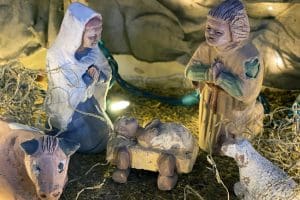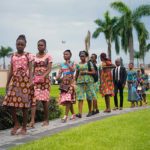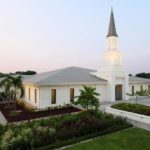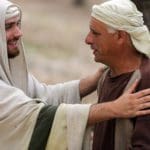![]()
 By Warren P. Aston
By Warren P. Aston
Photography by Scot Facer Proctor
Editor’s note: Meridian has published an earlier article by George Potter and Richard Wellington, presenting their theories of another possible solution to the question of where Nephi built the ship. See Discovering Nephi’s Harbor at Bountiful. The sites of the Book of Mormon events are not specifically known and the research is intriguing.
Warren and Michaela Aston have spent years exploring the coastline of Yemen and Oman searching for a place that matches the description that Nephi gives us in the Book of Mormon with some detail.
The Book of Mormon had been in print more than a century and a half before any Latter-day Saint attempted to see where the story of Lehi and Sariah took place. In 1976, Lynn and Hope Hilton of Salt Lake City were able to visit the country of Oman very briefly and see the fertile southern region reported by earlier writers. Although a civil war was just ending, limiting their visit to the area near the capital, Salalah, they reported seeing many of the features Nephi described. 1
I had been conducting Book of Mormon research in neighboring Yemen and in 1987, was able to obtain permission to travel in Oman, becoming the second Latter-day Saint researcher to do so.
I went with no thought other than of seeing for myself the unique and special place called by the Lehites “Bountiful,” the launching place for Nephi’s ship. In the days that followed however I began to realize that what I was seeing didn’t seem to match the detailed description Nephi had recorded. To be sure, the Salalah area with its irrigated plantations of palm trees and crops was picturesque and the inlet of Khor Rori offered a suitable port where a ship could be safely built and launched. But other essential features seemed to be missing.
To begin with, here was little natural vegetation except for grass and small bushes and trees set back in the hills across miles of barren plain. None of these trees seemed to offer “much fruit” – the very reason Bountiful was so named – or timber for building a ship. There was no obvious candidate for “the mount” where Nephi retired often to pray for guidance. And the fact that people had lived in this area for thousands of years seemed to clash with several aspects of Nephi’s story.
I began to re-examine the first eighteen chapters of First Nephi more closely for clues. Waiting to be mined proved to be a wealth of very specific detail about the place that had been “prepared of the Lord” (1 Nephi17:5) for Lehi, Sariah and their family (note – all references are from First Nephi):
- Firstly, Bountiful lay “nearly eastward” from Nahom, where Ishmael was buried (16:34, 17:1). My research in Yemen had already firmly linked the present-day tribal area of Nehem with Nahom, so Bountiful must lie close to the same latitude (about 16 degrees North).
- Obviously, there had to be access from Nahom to the coast. In some places mountains ranges are so steep at the Arabian coast that they cannot be crossed.
- Bountiful was a suitable coastal location where a ship could be built and launched.
- Nephi wrote twice that Bountiful was so named for its “much fruit and wild honey” (17:5, 6).
- Bountiful had timber suitable to construct a ship able to carry at least two dozen people (18: 1,2) for thousands of miles across the oceans.
- Year-round fresh water (rare in Arabia) must have been available to the group at the site.
- A nearby mountain where Nephi could go there and pray “oft,” (17:7, 18:3).
- The story of Nephi’s brothers attempting to kill him (17: 48) makes little sense unless there were high cliffs overlooking deep sea over which he could be thrown.
- Metal ore and flint must be in the area that could be located easily and smelted to make tools (17: 9-11, 16).
- Finally, a multitude of reasons suggest that there were probably no other people at Bountiful. If they were in a seaport town it hardly seems likely that a specific revelation would be needed to show Nephi where to obtain ore and the effort needed to smelt it and then fashion the tools he needed. He would not have had to rely on his brothers to assist him had local labor and expertise been available, nor frequent revelations about how to build the ship. Also, Laman and Lemuel could easily have returned to their beloved Jerusalem if they had merely arrived at the beginning of the incense trade route as some have suggested; instead they seem to have left willingly when the time came. 2
Put together, Nephi had painted a very precise word-picture of this last stopping place on their long land journey from Jerusalem. It was from this place they would voyage to the promised land in the New World and begin two great civilizations that would last a millennium.
But if the Salalah area was not the place, where on the Arabian coast could it be? Could the climate or sea level have changed in 2600 years enough to mask the location? Joseph Smith had put his entire prophetic credibility on the line when he included specific directions, highly detailed descriptions and even a place-name enroute in the account. His critics, however, attacked the story and in particular that Arabia could harbor a lush place where fruit and timber trees grew.
There and then I decided that Latter-day Saints deserved to know the answer to these questions and that we would never know them unless the entire south Arabian coast was properly explored.
Establishing Credibility
As the effort to explore the entire eastern coast of southern Arabia began, the credibility of the whole Arabian setting of the Book of Mormon was at stake. If no place matching Nephi’s Bountiful was found it could only mean that:
Since Nephi’s day, 2600 years ago, climate and coastline had changed
or
that Nephi’s account was fictitious.
Scientists today see little evidence of sea-level change in that region since Lehi’s day. In fact, the ruins of buildings at the coast firmly dated to Lehi’s time assure us that the sea level has changed little, if at all. 3 Nor is there any evidence of significant climate change in the past two millennia. 4
For these reasons the Book of Mormon was criticized for making the fantastic claim that Lehi’s group arrived at a fertile place with fruit and timber trees.
Exploring nine hundred miles of coastline on the ground, most of it in Yemen, however, proved to be a daunting task. Roads did not exist in many areas, and parts were closed for military use. Despite using a 4WD vehicle with an armed local guard, bandits, unpredictable gas supplies and poor maps led to many unintended, sometimes dramatic desert adventures – occasionally resolved only at gunpoint. Not until 1992 was the final stage covered, and for the first time Latter-day Saints then had objective data about the entire coast.
The grim reputation of the coast of the Arabian peninsula as an unrelenting, barren wasteland proved to be well deserved. In hundreds of miles of searching in Yemen I found only three places where there was any source of water at all; including the ancient incense shipping port of Qana or Bir Ali. Another was the mouth of the largest wadi in all of Arabia – the Hadhramaut.
None of the three sites had any timber trees. And, only miles from the border separating Yemen and Oman, the dramatic Qamar mountain ranges, thrusting some 3000 feet high, became a major barrier to exploration. After days exploring inland tracks, I used local fishermen to take me in their small boat along the coast by boat, discovering several sheltered bays that had rarely been seen by outsiders. It was in this way that the years of exploring unexpectedly paid off late one afternoon in October, 1989. 5
One of these bays, Khor Kharfot (“Fort Inlet”) proved to be the end of a long ravine winding through the mountains from the interior desert. This valley, Wadi Sayq (“River Valley”) led to the most fertile and lush coastal location anywhere in Arabia. A beautiful sand beach linked both sides of the bay with luxuriant vegetation and large timber trees lining the sides of the valley. The air was full of birds and insects. Wild bees produced honey in the caves that lined its sides. Springs and mountain run-off fed a large freshwater lagoon where the sea inlet once lay and a prominent peak stood on the western side of the bay with hundred foot cliffs at its base. Although we were later to find extensive ruins, the place was uninhabited and pristine. Except for metal ore (1 Nephi 16: 9-11, 16) each one of the elements of Nephi’s account was present.
Because this location was so impressive FARMS (the Foundation for Ancient Research and Mormon Studies), now a part of BYU in Provo, sponsored two expedition teams to Oman in 1993, sending a geologist and an archaeologist to make the first evaluation. We soon learned that the bay had been a sheltered sea inlet until the past few hundred years, when a sand bar closed it off to the ocean.
The ruins showed that the place had been inhabited several times in the distant past but not for long periods. In the valley’s interior I had already discovered huge seams of flint lying exposed on the ground. English botanists identified the timber trees as very suitable sea-resistant wood suitable for shipbuilding. One surviving tree measured some 47 feet in circumference; another stood more than a hundred feet tall – all a stone’s throw from the shoreline.
The final scriptural item, ore (Nephi did not specify which metal) fell into place shortly after, when BYU geologist Revell Phillips located iron ore that could be picked up by hand and be smelted into basic tools. 6 This discovery in Wadi Sayq and at one other location was the first time iron ore had ever been reported in Oman. As part of a long-term project BYU has been sending teams to Kharfot on a regular basis ever since.
Over the course of following years I discovered that a series of plateaus allowed travel in a “nearly eastward” direction (1 Nephi 17:1) over a straight route all the way from “Nahom” to the fertile area of coast in southern Oman. 7 To me, this finding demonstrated clearly that Nephi was both very accurate and literal when describing the desert journey. The capstone to my years of research in Yemen then came when three inscribed altars were excavated, confirming that the name “Nahom” indeed dated to between 600 and 700 BC, just as Nephi wrote. 8 Historian Terryl Givens describes the 1997 altar find as “the first actual archaeological evidence for the historicity of the Book of Mormon.” 9
These spectacular developments have not in some way “proved” that the Book of Mormon is true, any more than archaeology has been able to prove that the Bible is. What they have done however is establish Nephi’s account as completely plausible. No one can laugh at his story about arriving at a lush and fertile place in Arabia with timber trees.
Tourists today can retrace the Lehite’s steps, see exactly what Nephi described and ponder the likelihood that an unschooled farm boy in 1830 rural New York could have known of such a place. In fact, critics have been strangely quiet on the subject of “Bountiful” since the findings of this research began to be published in 1994.
Ultimately, “proof” of the truthfulness of the Book of Mormon still comes to each of us only in the way that Moroni outlined (Moroni 10:3-5). That will always be so. 10 The physical evidences described above are significant however because they enlarge and confirm our testimonies and give new depth to the scriptures. Perhaps they will become the means of bring the Book of Mormon to peoples who do not yet know it. They give us renewed appreciation for the faith of a boy-prophet who built a ship on the Arabian shore, the boy-prophet who preserved his words as his civilization collapsed around him and that of another boy-prophet who brought them forth in our day.
Only Two Sites
Over the years only two specific sites have been seriously proposed by Book of Mormon researchers as Nephi’s Bountiful: Khor Rori and Khor Kharfot, both in southern Oman.
It is important to remember that Nephi’s Bountiful was much, much more than just a suitable place to build and launch his ship. Twice we are told by Nephi that the very reason it was named Bountiful was because there was “much fruit” there (1 Nephi 17:5,6). Of course there had to also be a suitable sheltered harbor where a ship could be constructed and launched into the great ocean. The coast of southern Oman has several such bays, including both these sites. But it was the lushness of the place and its ability to provide all of the group’s needs that distinguished Bountiful from other bays.
Both these places have several features in common. Each lies “nearly eastward” of Nahom and can be reached from the interior desert. Both have sources of fresh water. They each have a sheltered harbor and each has cliffs overlooking the sea. We now know that both are within a few miles of an iron ore source. The differences between them, however, are striking.
On the one hand we have Khor Rori, in Lehi’s day a populated pagan town and in later times a busy shipping port, with little natural vegetation and no timber at all near the coast. The lack of timber has led some writers to suggest that it may have been imported from India as was done in northern Oman. Even today significant vegetation grows only in small irrigated areas at the coast or many miles inland. Khor Rori is surrounded by the broad and arid Salalah plains reaching inland to the Qara hills. There is no “mount” closer than twenty miles where Nephi could pray “oft.”
In contrast, Kharfot, hidden by the steep Qamar mountains, is the most fertile coastal location on the Arabian peninsula. Its fertility stretches several miles on each side of the bay. A variety of wild fruits and wild honey abounds and large timber trees grow – almost to the waters edge. A prominent mountain stands on the west side of the bay and at its base is an elevated plateau that would be ideal for a small community to live. It is a pristine place, almost certainly uninhabited in Lehi’s day.
These differences between the two places can be summarized as follows:
On balance, Khor Kharfot seems a much more convincing fit than Khor Rori. Over the years I have taken scores of seasoned Latter-day Saints to both sites and not a single person has ever felt otherwise. Typically, those who feel otherwise have not actually been to both sites to compare.
Click to Enlarge 
Maybe Nephi did walk forty miles round-trip to pray often in a mountain for guidance. Perhaps timber trees were available somewhere back in the Qara hills and perhaps the timber was brought down to the coast along with the abundant fruit he describes. Could Khor Rori have been the place “prepared of the Lord” where Lehi and Sariah’s group were led by the Liahona? Perhaps. But if it was, then a great opportunity was missed to use what is indisputably a vastly more lush location with all the elements on hand necessary to build and launch a ship, just fifty miles further west.
Notes:
1 Lynn & Hope Hilton, In Search of Lehi’s Trail (Salt Lake City: Deseret Book, 1976).
2. There would also seem to be little need for the Lord to provide the Liahona if all Lehi had to do was follow the trade route from Jerusalem all the way to Bountiful.
3. Sea level data is provided in D. T Potts, The Arabian Gulf in Antiquity (Oxford: Clarendon Press, 1990), 1: 12-16, especially his chart in Fig 1B. Also see M. J Tooley & I Shennan, eds. Sea-Level Changes (Oxford: Institute of British Geographers, Special Publication Series 20, 1987).
4. Of the many sources dealing with climate change on the Arabian Peninsula one of the most relevant is Margareta Tengberg “Wood Exploitation and Degradation of the vegetation cover in Eastern Arabia from the Bronze Age until early Islamic times,” paper presented July 21, 2005 at the Seminar for Arabian Studies, London.
5. The story of the survey and the discovery of Kharfot is described in Warren & Michaela Aston, In the Footsteps of Lehi (Salt Lake City: Deseret Book, 1994), also available in the LDS Collectors Library 2005 (LDS Media and Deseret Book, 2005).
6. W. Revell Phillips, “Metals of the Book of Mormon” in the Journal of Book of Mormon Studies (JBMS) 9/2 (Provo: FARMS, 2000), 36-41.
7. The plateau explored by the author is clearly evident in satellite mapping, see TPC mapping (GSGS) chart J-6C and J-7D on a 1:500,000 scale. The plateau leads eastwards from Nahom between two deserts and provides straight-line access to the fertile coast just as Nephi described.
8. See Warren P Aston, “Newly Found Altars from Nahom,” in JBMS 10/2 (Provo: FARMS, 2001), 56-61 is the fullest account of the altars to date.
9. Terryl Givens, By the Hand of Mormon: The American Scripture that Launched a New World Religion (New York: Oxford University Press, 2002), 120-121, 147.
10. An excellent and current discussion is found in Michael Ash, “Archaeological Evidence and the Book of Mormon,” available online at the FAIR site www.fairlds.org.
Kharfot is depiected as Bountiful in Daniel Ludlow, ed Encyclopedia of Mormonism (New York: MacMillan, 1991) 1:145 and in the selections published in To All the World: the Book of Mormon articles from the Encyclopedia of Mormonism (Salt Lake City: Deseret Book, 1993); in Light from the Dust, A Photographic Exploration into the Ancient World of the Book of Mormon (Salt Lake City: Deseret Book, 1993); in Warren and Michaela Aston, In the Footsteps of Lehi (Salt Lake City: Deseret Book, 1994); in Warren P. Aston, “The Arabian Bountiful Discovered?” Journal of Mormon Studies 7/1 (Provo: FARMS, 1998); and more recently in John W. Welch, Seely & Seely, eds. Glimpses of Lehi’s Jerusalem (Provo: FARMS, 2004) 77; and in the 2005 BYU/FARMS documentary film, Journey of Faith.
2006 Meridian Magazine. All Rights Reserved.

























